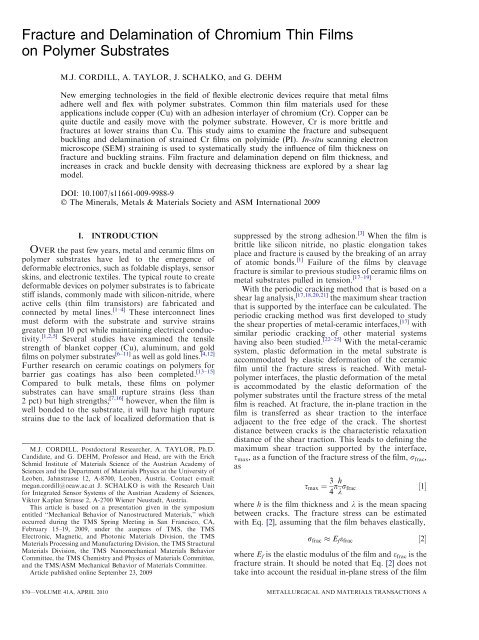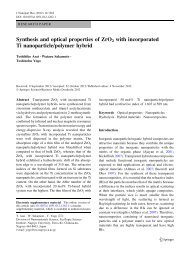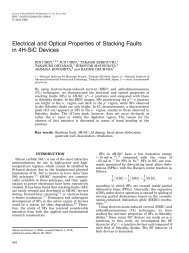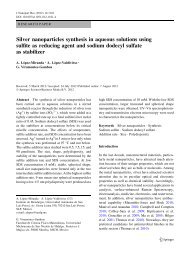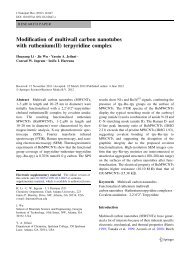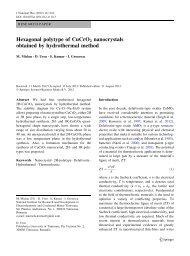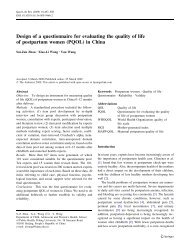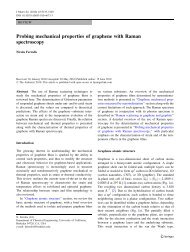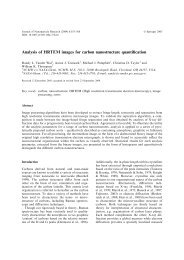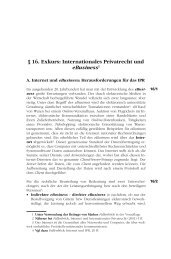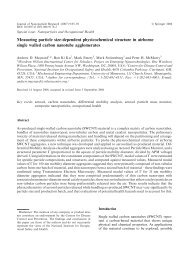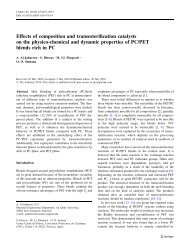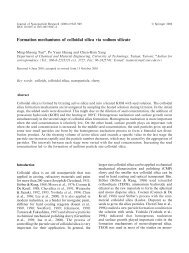Fracture and Delamination of Chromium Thin Films on Polymer ...
Fracture and Delamination of Chromium Thin Films on Polymer ...
Fracture and Delamination of Chromium Thin Films on Polymer ...
You also want an ePaper? Increase the reach of your titles
YUMPU automatically turns print PDFs into web optimized ePapers that Google loves.
<str<strong>on</strong>g>Fracture</str<strong>on</strong>g> <str<strong>on</strong>g>and</str<strong>on</strong>g> <str<strong>on</strong>g>Delaminati<strong>on</strong></str<strong>on</strong>g> <str<strong>on</strong>g>of</str<strong>on</strong>g> <str<strong>on</strong>g>Chromium</str<strong>on</strong>g> <str<strong>on</strong>g>Thin</str<strong>on</strong>g> <str<strong>on</strong>g>Films</str<strong>on</strong>g><br />
<strong>on</strong> <strong>Polymer</strong> Substrates<br />
M.J. CORDILL, A. TAYLOR, J. SCHALKO, <str<strong>on</strong>g>and</str<strong>on</strong>g> G. DEHM<br />
New emerging technologies in the field <str<strong>on</strong>g>of</str<strong>on</strong>g> flexible electr<strong>on</strong>ic devices require that metal films<br />
adhere well <str<strong>on</strong>g>and</str<strong>on</strong>g> flex with polymer substrates. Comm<strong>on</strong> thin film materials used for these<br />
applicati<strong>on</strong>s include copper (Cu) with an adhesi<strong>on</strong> interlayer <str<strong>on</strong>g>of</str<strong>on</strong>g> chromium (Cr). Copper can be<br />
quite ductile <str<strong>on</strong>g>and</str<strong>on</strong>g> easily move with the polymer substrate. However, Cr is more brittle <str<strong>on</strong>g>and</str<strong>on</strong>g><br />
fractures at lower strains than Cu. This study aims to examine the fracture <str<strong>on</strong>g>and</str<strong>on</strong>g> subsequent<br />
buckling <str<strong>on</strong>g>and</str<strong>on</strong>g> delaminati<strong>on</strong> <str<strong>on</strong>g>of</str<strong>on</strong>g> strained Cr films <strong>on</strong> polyimide (PI). In-situ scanning electr<strong>on</strong><br />
microscope (SEM) straining is used to systematically study the influence <str<strong>on</strong>g>of</str<strong>on</strong>g> film thickness <strong>on</strong><br />
fracture <str<strong>on</strong>g>and</str<strong>on</strong>g> buckling strains. Film fracture <str<strong>on</strong>g>and</str<strong>on</strong>g> delaminati<strong>on</strong> depend <strong>on</strong> film thickness, <str<strong>on</strong>g>and</str<strong>on</strong>g><br />
increases in crack <str<strong>on</strong>g>and</str<strong>on</strong>g> buckle density with decreasing thickness are explored by a shear lag<br />
model.<br />
DOI: 10.1007/s11661-009-9988-9<br />
Ó The Minerals, Metals & Materials Society <str<strong>on</strong>g>and</str<strong>on</strong>g> ASM Internati<strong>on</strong>al 2009<br />
I. INTRODUCTION<br />
OVER the past few years, metal <str<strong>on</strong>g>and</str<strong>on</strong>g> ceramic films <strong>on</strong><br />
polymer substrates have led to the emergence <str<strong>on</strong>g>of</str<strong>on</strong>g><br />
deformable electr<strong>on</strong>ics, such as foldable displays, sensor<br />
skins, <str<strong>on</strong>g>and</str<strong>on</strong>g> electr<strong>on</strong>ic textiles. The typical route to create<br />
deformable devices <strong>on</strong> polymer substrates is to fabricate<br />
stiff isl<str<strong>on</strong>g>and</str<strong>on</strong>g>s, comm<strong>on</strong>ly made with silic<strong>on</strong>-nitride, where<br />
active cells (thin film transistors) are fabricated <str<strong>on</strong>g>and</str<strong>on</strong>g><br />
c<strong>on</strong>nected by metal lines. [1–4] These interc<strong>on</strong>nect lines<br />
must deform with the substrate <str<strong>on</strong>g>and</str<strong>on</strong>g> survive strains<br />
greater than 10 pct while maintaining electrical c<strong>on</strong>ductivity.<br />
[1,2,5] Several studies have examined the tensile<br />
strength <str<strong>on</strong>g>of</str<strong>on</strong>g> blanket copper (Cu), aluminum, <str<strong>on</strong>g>and</str<strong>on</strong>g> gold<br />
films <strong>on</strong> polymer substrates [6–11] as well as gold lines. [4,12]<br />
Further research <strong>on</strong> ceramic coatings <strong>on</strong> polymers for<br />
barrier gas coatings has also been completed. [13–15]<br />
Compared to bulk metals, these films <strong>on</strong> polymer<br />
substrates can have small rupture strains (less than<br />
2 pct) but high strengths; [7,16] however, when the film is<br />
well b<strong>on</strong>ded to the substrate, it will have high rupture<br />
strains due to the lack <str<strong>on</strong>g>of</str<strong>on</strong>g> localized deformati<strong>on</strong> that is<br />
M.J. CORDILL, Postdoctoral Researcher, A. TAYLOR, Ph.D.<br />
C<str<strong>on</strong>g>and</str<strong>on</strong>g>idate, <str<strong>on</strong>g>and</str<strong>on</strong>g> G. DEHM, Pr<str<strong>on</strong>g>of</str<strong>on</strong>g>essor <str<strong>on</strong>g>and</str<strong>on</strong>g> Head, are with the Erich<br />
Schmid Institute <str<strong>on</strong>g>of</str<strong>on</strong>g> Materials Science <str<strong>on</strong>g>of</str<strong>on</strong>g> the Austrian Academy <str<strong>on</strong>g>of</str<strong>on</strong>g><br />
Sciences <str<strong>on</strong>g>and</str<strong>on</strong>g> the Department <str<strong>on</strong>g>of</str<strong>on</strong>g> Materials Physics at the University <str<strong>on</strong>g>of</str<strong>on</strong>g><br />
Leoben, Jahnstrasse 12, A-8700, Leoben, Austria. C<strong>on</strong>tact e-mail:<br />
megan.cordill@oeaw.ac.at J. SCHALKO is with the Research Unit<br />
for Integrated Sensor Systems <str<strong>on</strong>g>of</str<strong>on</strong>g> the Austrian Academy <str<strong>on</strong>g>of</str<strong>on</strong>g> Sciences,<br />
Viktor Kaplan Strasse 2, A-2700 Wiener Neustadt, Austria.<br />
This article is based <strong>on</strong> a presentati<strong>on</strong> given in the symposium<br />
entitled ‘‘Mechanical Behavior <str<strong>on</strong>g>of</str<strong>on</strong>g> Nanostructured Materials,’’ which<br />
occurred during the TMS Spring Meeting in San Francisco, CA,<br />
February 15–19, 2009, under the auspices <str<strong>on</strong>g>of</str<strong>on</strong>g> TMS, the TMS<br />
Electr<strong>on</strong>ic, Magnetic, <str<strong>on</strong>g>and</str<strong>on</strong>g> Phot<strong>on</strong>ic Materials Divisi<strong>on</strong>, the TMS<br />
Materials Processing <str<strong>on</strong>g>and</str<strong>on</strong>g> Manufacturing Divisi<strong>on</strong>, the TMS Structural<br />
Materials Divisi<strong>on</strong>, the TMS Nanomechanical Materials Behavior<br />
Committee, the TMS Chemistry <str<strong>on</strong>g>and</str<strong>on</strong>g> Physics <str<strong>on</strong>g>of</str<strong>on</strong>g> Materials Committee,<br />
<str<strong>on</strong>g>and</str<strong>on</strong>g> the TMS/ASM Mechanical Behavior <str<strong>on</strong>g>of</str<strong>on</strong>g> Materials Committee.<br />
Article published <strong>on</strong>line September 23, 2009<br />
suppressed by the str<strong>on</strong>g adhesi<strong>on</strong>. [3] When the film is<br />
brittle like silic<strong>on</strong> nitride, no plastic el<strong>on</strong>gati<strong>on</strong> takes<br />
place <str<strong>on</strong>g>and</str<strong>on</strong>g> fracture is caused by the breaking <str<strong>on</strong>g>of</str<strong>on</strong>g> an array<br />
<str<strong>on</strong>g>of</str<strong>on</strong>g> atomic b<strong>on</strong>ds. [1] Failure <str<strong>on</strong>g>of</str<strong>on</strong>g> the films by cleavage<br />
fracture is similar to previous studies <str<strong>on</strong>g>of</str<strong>on</strong>g> ceramic films <strong>on</strong><br />
metal substrates pulled in tensi<strong>on</strong>. [17–19]<br />
With the periodic cracking method that is based <strong>on</strong> a<br />
shear lag analysis, [17,18,20,21] the maximum shear tracti<strong>on</strong><br />
that is supported by the interface can be calculated. The<br />
periodic cracking method was first developed to study<br />
the shear properties <str<strong>on</strong>g>of</str<strong>on</strong>g> metal-ceramic interfaces, [17] with<br />
similar periodic cracking <str<strong>on</strong>g>of</str<strong>on</strong>g> other material systems<br />
having also been studied. [22–25] With the metal-ceramic<br />
system, plastic deformati<strong>on</strong> in the metal substrate is<br />
accommodated by elastic deformati<strong>on</strong> <str<strong>on</strong>g>of</str<strong>on</strong>g> the ceramic<br />
film until the fracture stress is reached. With metalpolymer<br />
interfaces, the plastic deformati<strong>on</strong> <str<strong>on</strong>g>of</str<strong>on</strong>g> the metal<br />
is accommodated by the elastic deformati<strong>on</strong> <str<strong>on</strong>g>of</str<strong>on</strong>g> the<br />
polymer substrates until the fracture stress <str<strong>on</strong>g>of</str<strong>on</strong>g> the metal<br />
film is reached. At fracture, the in-plane tracti<strong>on</strong> in the<br />
film is transferred as shear tracti<strong>on</strong> to the interface<br />
adjacent to the free edge <str<strong>on</strong>g>of</str<strong>on</strong>g> the crack. The shortest<br />
distance between cracks is the characteristic relaxati<strong>on</strong><br />
distance <str<strong>on</strong>g>of</str<strong>on</strong>g> the shear tracti<strong>on</strong>. This leads to defining the<br />
maximum shear tracti<strong>on</strong> supported by the interface,<br />
s max , as a functi<strong>on</strong> <str<strong>on</strong>g>of</str<strong>on</strong>g> the fracture stress <str<strong>on</strong>g>of</str<strong>on</strong>g> the film, r frac ,<br />
as<br />
s max ¼ 3 4 ph k r frac<br />
where h is the film thickness <str<strong>on</strong>g>and</str<strong>on</strong>g> k is the mean spacing<br />
between cracks. The fracture stress can be estimated<br />
with Eq. [2], assuming that the film behaves elastically,<br />
r frac E f e frac<br />
where E f is the elastic modulus <str<strong>on</strong>g>of</str<strong>on</strong>g> the film <str<strong>on</strong>g>and</str<strong>on</strong>g> e frac is the<br />
fracture strain. It should be noted that Eq. [2] does not<br />
take into account the residual in-plane stress <str<strong>on</strong>g>of</str<strong>on</strong>g> the film<br />
½1Š<br />
½2Š<br />
870—VOLUME 41A, APRIL 2010<br />
METALLURGICAL AND MATERIALS TRANSACTIONS A
after depositi<strong>on</strong>. It is easily included, as shown by<br />
Anders<strong>on</strong>s <str<strong>on</strong>g>and</str<strong>on</strong>g> Leterrier et al. [13–15] Similar shear lag<br />
analyses have been performed with SiO 2 -PET film<br />
systems as well as SiN x -Kapt<strong>on</strong> film systems. [13–15]<br />
However, some differences are found between the<br />
preceding approach <str<strong>on</strong>g>and</str<strong>on</strong>g> others, [17,18] but both are based<br />
<strong>on</strong> the shear lag analysis <str<strong>on</strong>g>of</str<strong>on</strong>g> Kelly <str<strong>on</strong>g>and</str<strong>on</strong>g> Tys<strong>on</strong>. [26]<br />
In-situ tensile tests performed inside a scanning<br />
electr<strong>on</strong> microscope (SEM) allow <strong>on</strong>e to determine the<br />
system’s fracture strain, where cracks first initiate, as<br />
well as any subsequent buckling <str<strong>on</strong>g>and</str<strong>on</strong>g> delaminati<strong>on</strong> that<br />
may occur. [19] This type <str<strong>on</strong>g>of</str<strong>on</strong>g> experiment can provide a<br />
wealth <str<strong>on</strong>g>of</str<strong>on</strong>g> informati<strong>on</strong> that can be used to improve<br />
existing adhesi<strong>on</strong> <str<strong>on</strong>g>and</str<strong>on</strong>g> deformati<strong>on</strong> models currently<br />
being implemented [1,27] to predict material failure <str<strong>on</strong>g>and</str<strong>on</strong>g><br />
lifetimes <str<strong>on</strong>g>of</str<strong>on</strong>g> the material systems. Current thin film<br />
systems being examined for the c<strong>on</strong>necting lines <str<strong>on</strong>g>of</str<strong>on</strong>g><br />
flexible devices include Cu or Au with an adhesi<strong>on</strong> layer<br />
<str<strong>on</strong>g>of</str<strong>on</strong>g> chromium (Cr). It has been well known that Cr can<br />
increase the adhesi<strong>on</strong> energy <str<strong>on</strong>g>of</str<strong>on</strong>g> metal films <strong>on</strong> polymer<br />
substrates, for example, Cu <strong>on</strong> PI [27] <str<strong>on</strong>g>and</str<strong>on</strong>g> Au <strong>on</strong><br />
PDMS. [13] It has also been observed that Cr adhesi<strong>on</strong><br />
layers (10 to 20 nm in thickness) will fracture before<br />
cracks are viewed in the overlying Cu films, <str<strong>on</strong>g>and</str<strong>on</strong>g> the<br />
failure occurs via channel cracking perpendicular to the<br />
tensile loading directi<strong>on</strong>. [24] This study aims to examine<br />
the fracture behavior <str<strong>on</strong>g>of</str<strong>on</strong>g> bare Cr films <strong>on</strong> PI substrates to<br />
better underst<str<strong>on</strong>g>and</str<strong>on</strong>g> the mechanisms that lead to failure <str<strong>on</strong>g>of</str<strong>on</strong>g><br />
this adhesi<strong>on</strong> layer. Of importance is whether fracture<br />
strain is influenced by the film thickness.<br />
microscopy (TEM) images <str<strong>on</strong>g>and</str<strong>on</strong>g> diffracti<strong>on</strong> patterns <str<strong>on</strong>g>of</str<strong>on</strong>g><br />
the 50- <str<strong>on</strong>g>and</str<strong>on</strong>g> 500-nm films were taken. Figure 1 shows a<br />
columnar grain structure with peculiar peaks for both<br />
film thicknesses. The peaks are also visible in scanning<br />
electr<strong>on</strong> microscopy images <str<strong>on</strong>g>of</str<strong>on</strong>g> the film surfaces (not<br />
shown). Diffracti<strong>on</strong> patterns indicate that the films are<br />
polycrystalline. The average grain size <str<strong>on</strong>g>of</str<strong>on</strong>g> the films is <strong>on</strong><br />
the order <str<strong>on</strong>g>of</str<strong>on</strong>g> 50 nm for all film thicknesses.<br />
The films were pulled in tensi<strong>on</strong> using a small scale<br />
tensile device (Kammrath <str<strong>on</strong>g>and</str<strong>on</strong>g> Weiss, Dortmund,<br />
Germany) that has a maximum displacement <str<strong>on</strong>g>of</str<strong>on</strong>g> 6 mm.<br />
The sample geometry used was approximately 1-cm<br />
wide with a 3-cm gage length. Each test was carried out<br />
using a 10-lm/s displacement rate. The tensile device<br />
was used to perform both ex-situ <str<strong>on</strong>g>and</str<strong>on</strong>g> in-situ tests inside<br />
the SEM. In-situ tests were initially stopped every 100<br />
lm <str<strong>on</strong>g>of</str<strong>on</strong>g> displacement until the first cracks perpendicular<br />
to the tensile directi<strong>on</strong> were observed (approximately<br />
600-lm total displacement) in order for SEM images to<br />
be taken <str<strong>on</strong>g>of</str<strong>on</strong>g> the samples at various magnificati<strong>on</strong>s. After<br />
the first 600 lm <str<strong>on</strong>g>of</str<strong>on</strong>g> displacement, the experiment was<br />
stopped every 200 lm <str<strong>on</strong>g>of</str<strong>on</strong>g> displacement. The images were<br />
then correlated to the strain. Comparis<strong>on</strong>s <str<strong>on</strong>g>of</str<strong>on</strong>g> ex-situ<br />
<str<strong>on</strong>g>and</str<strong>on</strong>g> in-situ tests indicate that the electr<strong>on</strong> beam <str<strong>on</strong>g>and</str<strong>on</strong>g> the<br />
vacuum do not alter the results notably.<br />
II. EXPERIMENTAL PROCEDURE<br />
<str<strong>on</strong>g>Chromium</str<strong>on</strong>g> films were deposited <strong>on</strong>to cleaned 50-lmthick<br />
UPLIEX br<str<strong>on</strong>g>and</str<strong>on</strong>g> PI films (E = 8.5 GPa). The PI<br />
film was cleaned by soaking it in a 10 pct aqueous<br />
soluti<strong>on</strong> <str<strong>on</strong>g>of</str<strong>on</strong>g> RBS 50 (a laboratory cleaning c<strong>on</strong>centrate<br />
with high pH) for 24 hours at room temperature,<br />
followed by a dei<strong>on</strong>ized water rinse <str<strong>on</strong>g>and</str<strong>on</strong>g> a 1 MHz<br />
ultras<strong>on</strong>ic cleaning process. The Cr layers were deposited<br />
by e-beam evaporati<strong>on</strong> in a Balzers BAK 550<br />
evaporati<strong>on</strong> machine with the vacuum at 2.10 9<br />
10 7 mbar <str<strong>on</strong>g>and</str<strong>on</strong>g> using a depositi<strong>on</strong> rate <str<strong>on</strong>g>of</str<strong>on</strong>g> 0.5 nm/s.<br />
Four film thicknesses were made <str<strong>on</strong>g>and</str<strong>on</strong>g> studied: 50, 100,<br />
200, <str<strong>on</strong>g>and</str<strong>on</strong>g> 500 nm. It is known that adhesi<strong>on</strong> layers are<br />
comm<strong>on</strong>ly 50 nm or less; however, in order to fully<br />
study the failure mechanism, an order <str<strong>on</strong>g>of</str<strong>on</strong>g> magnitude <str<strong>on</strong>g>of</str<strong>on</strong>g><br />
film thickness was used. The 100-, 200-, <str<strong>on</strong>g>and</str<strong>on</strong>g> 500-nm<br />
films have residual tensile stresses <strong>on</strong> the order <str<strong>on</strong>g>of</str<strong>on</strong>g> 1 GPa<br />
(1.2, 1, <str<strong>on</strong>g>and</str<strong>on</strong>g> 0.8 GPa, for the 100, 200, <str<strong>on</strong>g>and</str<strong>on</strong>g> 500 nm,<br />
respectively), as determined by X-ray diffracti<strong>on</strong> using<br />
the sin 2 W method. The same method was also used <strong>on</strong><br />
the 50-nm film but was unsuccessful in measuring a<br />
stress because the film was too thin to get a reliable peak<br />
shift. In the analysis, a 1-GPa residual stress is assumed<br />
for the 50-nm film. Tensile cracks formed before<br />
straining experiments <str<strong>on</strong>g>of</str<strong>on</strong>g> the 200- <str<strong>on</strong>g>and</str<strong>on</strong>g> 500-nm films.<br />
The structure <str<strong>on</strong>g>of</str<strong>on</strong>g> the films was determined with<br />
electr<strong>on</strong> microscopy techniques. By careful sample<br />
preparati<strong>on</strong>, cross-secti<strong>on</strong>al transmissi<strong>on</strong> electr<strong>on</strong><br />
Fig. 1—Bright-field TEM images <str<strong>on</strong>g>of</str<strong>on</strong>g> the (a) 50- <str<strong>on</strong>g>and</str<strong>on</strong>g> (b) 500-nm-thick<br />
films. The arrows in (a) indicate regi<strong>on</strong>s <str<strong>on</strong>g>of</str<strong>on</strong>g> possible columnar<br />
porosity.<br />
METALLURGICAL AND MATERIALS TRANSACTIONS A VOLUME 41A, APRIL 2010—871
III. RESULTS AND DISCUSSION<br />
The load vs strain behavior <str<strong>on</strong>g>of</str<strong>on</strong>g> the Cr films <strong>on</strong> PI is<br />
shown in Figure 2(a) for ex-situ experiments. Both<br />
ex-situ <str<strong>on</strong>g>and</str<strong>on</strong>g> in-situ experiments illustrate that there is no<br />
pr<strong>on</strong>ounced thickness dependence <strong>on</strong> the load <str<strong>on</strong>g>and</str<strong>on</strong>g> strain<br />
resp<strong>on</strong>se. This may be explained by the small grain size<br />
<str<strong>on</strong>g>of</str<strong>on</strong>g> 50 nm, which is for all thicknesses the smallest<br />
dimensi<strong>on</strong> <str<strong>on</strong>g>and</str<strong>on</strong>g> thus expected to c<strong>on</strong>trol the mechanical<br />
resp<strong>on</strong>se <str<strong>on</strong>g>of</str<strong>on</strong>g> the films. [25] The ex-situ samples were all<br />
strained to 11 pct, while in-situ tests were performed to<br />
12 to 18 pct strain. With the in-situ experiments, cracks<br />
perpendicular to the loading directi<strong>on</strong> were observed to<br />
initiate at less than 1 pct strain for all thicknesses<br />
(Table I). Measured crack densities increase with<br />
decreasing film thickness (Figure 2(b)). The crack density<br />
<str<strong>on</strong>g>of</str<strong>on</strong>g> the thickest film (500 nm) reaches a steady state<br />
at about 4 pct strain, which is at a lower strain value<br />
than the thinner films. The 100- <str<strong>on</strong>g>and</str<strong>on</strong>g> 200-nm films reach<br />
a steady state at approximately 5 pct strain. Figure 3<br />
illustrates the cracking found in all four thicknesses at<br />
11 pct strain. Crack density as a functi<strong>on</strong> <str<strong>on</strong>g>of</str<strong>on</strong>g> strain <str<strong>on</strong>g>of</str<strong>on</strong>g> the<br />
films 100 nm <str<strong>on</strong>g>and</str<strong>on</strong>g> greater reaches a clear plateau in the<br />
data indicating the steady state. The thinnest film,<br />
50 nm, does not reach such a plateau within the<br />
prescribed straining limit <str<strong>on</strong>g>of</str<strong>on</strong>g> the apparatus. Rather, a<br />
change in slope is reached at about 7 pct strain <str<strong>on</strong>g>and</str<strong>on</strong>g> then<br />
c<strong>on</strong>tinues to gradually increase, up to 18 pct global<br />
strain. This indicates that cracks are still forming in the<br />
very thin brittle films where cracks stop forming in the<br />
thicker films. The c<strong>on</strong>tinued crack growth could be <str<strong>on</strong>g>of</str<strong>on</strong>g><br />
significance <str<strong>on</strong>g>and</str<strong>on</strong>g> may aid in increasing the strain a<br />
system can withst<str<strong>on</strong>g>and</str<strong>on</strong>g>. The average crack spacing at<br />
saturati<strong>on</strong> can also be found in Table I.<br />
Due to the fact that the fracture strains <str<strong>on</strong>g>of</str<strong>on</strong>g> the films<br />
can be observed with the in-situ experiments, it is easy to<br />
calculate the maximum shear stress <str<strong>on</strong>g>of</str<strong>on</strong>g> the interface,<br />
s max , assuming that the fracture stress can be estimated<br />
based <strong>on</strong> Eq. [2] with an elastic modulus <str<strong>on</strong>g>of</str<strong>on</strong>g> 280 GPa.<br />
Since the grain size is homogenous for the various film<br />
thicknesses <str<strong>on</strong>g>and</str<strong>on</strong>g> too small to allow c<strong>on</strong>siderable plasticity,<br />
this approximati<strong>on</strong> is justified. There is a wide<br />
distributi<strong>on</strong> <str<strong>on</strong>g>of</str<strong>on</strong>g> observed fracture strains but a trend <str<strong>on</strong>g>of</str<strong>on</strong>g><br />
decreasing fracture strain with increasing film thickness<br />
is found, as shown in Table I. The fracture strain is<br />
defined when the first new cracks perpendicular to the<br />
tensile directi<strong>on</strong> are observed with the SEM during the<br />
in-situ experiment. Using Eq. [1] <str<strong>on</strong>g>and</str<strong>on</strong>g> the fracture stress<br />
values from Eq. [2], the maximum shear stress <str<strong>on</strong>g>of</str<strong>on</strong>g> the<br />
interface also decreases with increasing film thickness, as<br />
shown in Table I. The calculated values for the Cr-PI<br />
system are lower (119 to 31 MPa) than that <str<strong>on</strong>g>of</str<strong>on</strong>g> a metalceramic<br />
interface (1.7 GPa for Cu-SiO 2 <str<strong>on</strong>g>and</str<strong>on</strong>g> 0.4 to<br />
[14]<br />
0.8 GPa for Cu-Al 2 O [28] 3 ), but the values are reas<strong>on</strong>able.<br />
It should be noted that the residual stresses in the<br />
thicker films (>100 nm) have not been c<strong>on</strong>sidered with<br />
this model. Rather, the formati<strong>on</strong> <str<strong>on</strong>g>of</str<strong>on</strong>g> new cracks due to<br />
the tensile loading is c<strong>on</strong>sidered to be the over-riding<br />
mechanism. When the residual stress <str<strong>on</strong>g>of</str<strong>on</strong>g> about 1 GPa <str<strong>on</strong>g>of</str<strong>on</strong>g><br />
the films is included in the analysis, the fracture stresses<br />
range between 3.1 <str<strong>on</strong>g>and</str<strong>on</strong>g> 1.2 GPa <str<strong>on</strong>g>and</str<strong>on</strong>g> the maximum<br />
interface shear strength values increase to 175 to<br />
Fig. 2—(a) Load vs strain resp<strong>on</strong>se <str<strong>on</strong>g>of</str<strong>on</strong>g> the four Cr film thicknesses<br />
<strong>on</strong> PI. (b) Crack density as a functi<strong>on</strong> <str<strong>on</strong>g>of</str<strong>on</strong>g> strain for all four Cr thicknesses.<br />
Each thickness reaches the steady-state regi<strong>on</strong> at a different<br />
strain ranging between 4 <str<strong>on</strong>g>and</str<strong>on</strong>g> 7 pct. The 50-nm-thick film, however,<br />
does not quite reach a steady state. Rather, the slope <str<strong>on</strong>g>of</str<strong>on</strong>g> the data<br />
changes (arrow) at about 7 pct.<br />
93 MPa, respectively, for the 50- to 500-nm film. These<br />
values are shown in brackets (i.e., [175]) in Table I. In<br />
either case, the data show a tendency for the thinner<br />
films to have higher interfacial shear strengths, which is<br />
most likely caused by the decrease in fracture stress due<br />
to a scaling with the film thickness because the grain size<br />
is c<strong>on</strong>stant for all thicknesses. A possible explanati<strong>on</strong><br />
could be the presence <str<strong>on</strong>g>of</str<strong>on</strong>g> columnar porosity, [29,30] comm<strong>on</strong>ly<br />
observed with columnar grained films. This type<br />
<str<strong>on</strong>g>of</str<strong>on</strong>g> defect may be present in these films, as shown in<br />
Figure 1(a) (arrows) at the column boundaries. Further<br />
TEM examinati<strong>on</strong> is required in order to say with<br />
872—VOLUME 41A, APRIL 2010<br />
METALLURGICAL AND MATERIALS TRANSACTIONS A
Film Thickness<br />
Table I. Measured <str<strong>on</strong>g>and</str<strong>on</strong>g> Calculated Values <str<strong>on</strong>g>of</str<strong>on</strong>g> <str<strong>on</strong>g>Fracture</str<strong>on</strong>g> Strain <str<strong>on</strong>g>and</str<strong>on</strong>g> Stress, Average Crack <str<strong>on</strong>g>and</str<strong>on</strong>g> Buckle Spacing,<br />
<str<strong>on</strong>g>and</str<strong>on</strong>g> Maximum Interface Shear Strength for All Performed In-Situ Experiments; Values that Include<br />
the Residual Tensile Stress <str<strong>on</strong>g>of</str<strong>on</strong>g> 1 GPa are Shown in Brackets<br />
Pct <str<strong>on</strong>g>Fracture</str<strong>on</strong>g><br />
Strain<br />
<str<strong>on</strong>g>Fracture</str<strong>on</strong>g><br />
Stress (GPa)<br />
Average Crack<br />
Spacing (lm)<br />
Maximum Interface<br />
Shear Strength (MPa)<br />
Pct Buckle<br />
Strain<br />
Average Buckle<br />
Spacing (lm)<br />
50 nm 0.58 1.6 [2.6]* 1.9 ± 0.1 100 [163]* 8 4.4 ± 1.5<br />
0.76 2.1 [3.1]* 2.1 ± 0.2 119 [175]* 13<br />
100 nm 0.32 0.9 [2.1] 4.1 ± 0.5 52 [120] 13 11 ± 6<br />
200 nm 0.23 0.64 [1.6] 4.8 ± 0.4 64 [161] 17 12 ± 5.9<br />
500 nm 0.15 0.42 [1.2] 15.5 ± 0.5 31 [93] 10 62 ± 35<br />
0.19 0.54 [1.3] 16.7 ± 1 38 [94] 10<br />
*The residual stress <str<strong>on</strong>g>of</str<strong>on</strong>g> the 50-nm film could not be measured <str<strong>on</strong>g>and</str<strong>on</strong>g> was assumed to be 1 GPa <str<strong>on</strong>g>and</str<strong>on</strong>g> was based <strong>on</strong> the stress results <str<strong>on</strong>g>of</str<strong>on</strong>g> the other films.<br />
Fig. 3—The SEM micrographs at the same magnificati<strong>on</strong> <str<strong>on</strong>g>of</str<strong>on</strong>g> all four films strained to 12 pct. The effect that thickness has <strong>on</strong> crack spacing is<br />
evident as well as the first stages <str<strong>on</strong>g>of</str<strong>on</strong>g> buckling in the 500-nm film. (a) 50-nm, (b) 100-nm, (c) 200-nm, <str<strong>on</strong>g>and</str<strong>on</strong>g> (d) 500-nm.<br />
certainty how columnar porosity should be taken into<br />
account. Larger defects in the thicker films, e.g., cracks<br />
caused by residual stresses from depositi<strong>on</strong>, will cause a<br />
lower fracture stress <str<strong>on</strong>g>and</str<strong>on</strong>g> as a c<strong>on</strong>sequence the simple<br />
model provides <strong>on</strong>ly an upper limit <str<strong>on</strong>g>of</str<strong>on</strong>g> the interfacial<br />
shear strength. However, the large crack density <str<strong>on</strong>g>and</str<strong>on</strong>g><br />
lack <str<strong>on</strong>g>of</str<strong>on</strong>g> a steady-state regime may be a cause for<br />
overlayers <str<strong>on</strong>g>of</str<strong>on</strong>g> Cu or gold to fail.<br />
Increasing the strain <str<strong>on</strong>g>of</str<strong>on</strong>g> the film system leads to<br />
delaminati<strong>on</strong> <str<strong>on</strong>g>and</str<strong>on</strong>g> buckling at the interface. Buckling is<br />
caused by the lateral compressive deformati<strong>on</strong> <str<strong>on</strong>g>of</str<strong>on</strong>g> the<br />
film <strong>on</strong> the substrate due to the different Poiss<strong>on</strong>’s<br />
ratios <str<strong>on</strong>g>of</str<strong>on</strong>g> Cr <str<strong>on</strong>g>and</str<strong>on</strong>g> PI (0.21 <str<strong>on</strong>g>and</str<strong>on</strong>g> 0.3, respectively). This<br />
occurs above ~10 pct strain al<strong>on</strong>g the tensile directi<strong>on</strong>,<br />
with the exact amount <str<strong>on</strong>g>of</str<strong>on</strong>g> strain depending <strong>on</strong> the film<br />
thickness. The nature <str<strong>on</strong>g>of</str<strong>on</strong>g> the buckling is also dependent<br />
<strong>on</strong> film thickness. With the 500-nm film, buckles form<br />
with a crack at the apex <str<strong>on</strong>g>and</str<strong>on</strong>g> at the edges <str<strong>on</strong>g>of</str<strong>on</strong>g> the buckle,<br />
forming a triangle buckle, which can lead to immediate<br />
spalling <str<strong>on</strong>g>of</str<strong>on</strong>g> the film. On the other h<str<strong>on</strong>g>and</str<strong>on</strong>g>, the 50-nm film<br />
METALLURGICAL AND MATERIALS TRANSACTIONS A VOLUME 41A, APRIL 2010—873
Fig. 4—SEM images <str<strong>on</strong>g>of</str<strong>on</strong>g> buckles found <strong>on</strong> the (a) 50- <str<strong>on</strong>g>and</str<strong>on</strong>g> the (b) 500-nm films.<br />
buckles are much smaller <str<strong>on</strong>g>and</str<strong>on</strong>g> form straight buckles<br />
between the initial cracks with a cracked apex as well.<br />
Figure 4 shows examples <str<strong>on</strong>g>of</str<strong>on</strong>g> the buckling with the two<br />
film thicknesses. Inspecti<strong>on</strong> <str<strong>on</strong>g>of</str<strong>on</strong>g> the buckling behavior<br />
may be a way to determine the work <str<strong>on</strong>g>of</str<strong>on</strong>g> separati<strong>on</strong> <str<strong>on</strong>g>of</str<strong>on</strong>g><br />
the film system. Further experiments combined with<br />
modeling are currently under way to examine this<br />
behavior.<br />
IV. CONCLUSIONS<br />
The failure <str<strong>on</strong>g>of</str<strong>on</strong>g> blanket chromium films comm<strong>on</strong>ly<br />
used as adhesi<strong>on</strong> layers to increase the interfacial<br />
strength <str<strong>on</strong>g>of</str<strong>on</strong>g> metal-polymer film systems has been investigated.<br />
Under tensi<strong>on</strong>, Cr films fracture <str<strong>on</strong>g>and</str<strong>on</strong>g> delaminate<br />
from the PI substrate with a brittle cleavage fracture<br />
behavior. Initial crack formati<strong>on</strong> perpendicular to the<br />
loading directi<strong>on</strong> occurs at strains less than 1 pct, much<br />
lower than the fracture strain <str<strong>on</strong>g>of</str<strong>on</strong>g> the Cu films whose<br />
adhesi<strong>on</strong> is being improved in applicati<strong>on</strong>s. The cracking<br />
behavior can be compared to ceramic films <strong>on</strong> metal<br />
substrates pulled in tensi<strong>on</strong>, <str<strong>on</strong>g>and</str<strong>on</strong>g> a periodic cracking<br />
model for calculating the maximum interface shear<br />
strength was used. The average interface shear strength<br />
is 67 ± 35 MPa. The spacing <str<strong>on</strong>g>of</str<strong>on</strong>g> the cracks reaches a<br />
steady state at approximately 4 to 5 pct strain for thick<br />
films (‡100 nm). For 50-nm-thick films, the crack<br />
density does not reach a steady-state regi<strong>on</strong> even after<br />
18 pct global strain has been induced. Crack <str<strong>on</strong>g>and</str<strong>on</strong>g> buckle<br />
spacings also increase with increasing film thickness,<br />
with buckles occurring at 8 to 17 pct strain depending<br />
<strong>on</strong> film thickness. These buckles can be used to measure<br />
adhesi<strong>on</strong> energies by taking the shape <str<strong>on</strong>g>and</str<strong>on</strong>g> possible<br />
cracks <str<strong>on</strong>g>of</str<strong>on</strong>g> the buckles into account. This study has shown<br />
that thin adhesi<strong>on</strong> interlayers c<strong>on</strong>tinue to form cracks<br />
during tensile deformati<strong>on</strong> up to high strains. The<br />
c<strong>on</strong>tinued fracture process <str<strong>on</strong>g>and</str<strong>on</strong>g> large crack density may<br />
cause metal bilayer systems <strong>on</strong> polymers (e.g., Cu film<br />
<strong>on</strong> Cr adhesi<strong>on</strong> layer) to be less reliable than a thicker<br />
adhesi<strong>on</strong> layer with a lower crack density.<br />
ACKNOWLEDGMENTS<br />
Funding for this research has been provided by the<br />
FWF Lise Meitner fellowship (Grant No. M1041-<br />
N14). P. Svasek, Research Unit for Integrated Sensor<br />
Systems, Austrian Academy <str<strong>on</strong>g>of</str<strong>on</strong>g> Sciences (Vienna), is<br />
acknowledged for sample preparati<strong>on</strong> help. R. Raj <str<strong>on</strong>g>and</str<strong>on</strong>g><br />
F.D. Fischer are gratefully acknowledged for helpful<br />
discussi<strong>on</strong>s. K. Martinschitz <str<strong>on</strong>g>and</str<strong>on</strong>g> J. Keckes, Materials<br />
Physics Department, University <str<strong>on</strong>g>of</str<strong>on</strong>g> Leoben, are also<br />
acknowledged for help with the XRD analysis.<br />
REFERENCES<br />
1. T. Li, Z.Y. Huang, Z.C. Xi, S.P. Lacour, S. Wagner, <str<strong>on</strong>g>and</str<strong>on</strong>g> Z. Suo:<br />
Mech. Mater., 2005, vol. 37, pp. 261–73.<br />
2. S.P. Lacour, C. Tsay, <str<strong>on</strong>g>and</str<strong>on</strong>g> S. Wagner: IEEE Electr<strong>on</strong> Dev. Lett.,<br />
2004, vol. 25, pp. 792–94.<br />
3. Y. Xiang, T. Li, Z. Suo, <str<strong>on</strong>g>and</str<strong>on</strong>g> J. Vlassak: Appl. Phys. Lett., 2005,<br />
vol. 87, pp. 161910-1–161910-3.<br />
4. S.P. Lacour, S. Wagner, R.J. Narayan, L. Teng, <str<strong>on</strong>g>and</str<strong>on</strong>g> Z. Suo:<br />
J. Appl. Phys., 2006, vol. 100, pp. 014913-1–014913-3.<br />
5. S.P. Lacour, J. J<strong>on</strong>es, S. Wagner, L. Teng, <str<strong>on</strong>g>and</str<strong>on</strong>g> S. Zhigang: Proc.<br />
IEEE, 2005, vol. 93, pp. 1459–67.<br />
6. O. Kraft, M. Hommel, <str<strong>on</strong>g>and</str<strong>on</strong>g> E. Arzt: Mater. Sci. Eng. A, 2000,<br />
vol. 88, pp. 209–16.<br />
7. D.Y.W. Yu <str<strong>on</strong>g>and</str<strong>on</strong>g> F. Spaepen: J. Appl. Phys., 2004, vol. 95,<br />
pp. 2991–97.<br />
8. P.O. Renault, P. Villian, C. Coupeau, P. Goudeau, <str<strong>on</strong>g>and</str<strong>on</strong>g><br />
K.F. Badawi: <str<strong>on</strong>g>Thin</str<strong>on</strong>g> Solid <str<strong>on</strong>g>Films</str<strong>on</strong>g>, 2003, vol. 424, pp. 267–73.<br />
9. S.H. Oh, M. Legros, D. Kiener, P. Gruber, <str<strong>on</strong>g>and</str<strong>on</strong>g> G. Dehm: Acta<br />
Mater., 2007, vol. 55, pp. 5558–71.<br />
10. G. Dehm, S.H. Oh, P. Gruber, M. Legros, <str<strong>on</strong>g>and</str<strong>on</strong>g> F.D. Fischer: Acta<br />
Mater., 2007, vol. 55, pp. 6659–65.<br />
11. P.A. Gruber, J. Bohm, F. Onuseit, A. Wanner, R. Spolenak, <str<strong>on</strong>g>and</str<strong>on</strong>g><br />
E. Arzt: Acta Mater., 2008, vol. 56, pp. 2318–35.<br />
12. S. Olliges, P.A. Gruber, S. Orso, V. Auzelyte, Y. Ekinci,<br />
H.H. Solak, <str<strong>on</strong>g>and</str<strong>on</strong>g> R. Spolenak: Scripta Mater., 2008, vol. 58,<br />
pp. 175–78.<br />
13. J. Anders<strong>on</strong>s, Y. Leterrier, G. Tornare, P. Dum<strong>on</strong>t, <str<strong>on</strong>g>and</str<strong>on</strong>g> J.-A.E.<br />
Mans<strong>on</strong>: Mech. Mater., 2007, vol. 39, pp. 834–44.<br />
14. Y. Leterrier: Prog. Mater. Sci., 2003, vol. 48, pp. 1–55.<br />
15. Y. Leterrier, J. Anders<strong>on</strong>s, Y. Pitt<strong>on</strong>, <str<strong>on</strong>g>and</str<strong>on</strong>g> J.-A.E. Mans<strong>on</strong>:<br />
J. Polym. Sci. B, 1998, vol. 35, pp. 1463–72.<br />
16. S.P. Lacour, S. Wagner, H. Zhenyu, <str<strong>on</strong>g>and</str<strong>on</strong>g> Z. Suo: Appl. Phys. Lett.,<br />
2003, vol. 82, pp. 2404–06.<br />
874—VOLUME 41A, APRIL 2010<br />
METALLURGICAL AND MATERIALS TRANSACTIONS A
17. D.C. Agrawal <str<strong>on</strong>g>and</str<strong>on</strong>g> R. Raj: Acta Metall., 1989, vol. 37, pp. 1265–70.<br />
18. V.C. Jobin, R. Raj, <str<strong>on</strong>g>and</str<strong>on</strong>g> S.L. Phoenix: Acta Metall. Mater., 1992,<br />
vol. 40, pp. 2269–80.<br />
19. G. Rochat, Y. Leterrier, P. Fayet, <str<strong>on</strong>g>and</str<strong>on</strong>g> J.-A.E. Mans<strong>on</strong>: <str<strong>on</strong>g>Thin</str<strong>on</strong>g> Solid<br />
<str<strong>on</strong>g>Films</str<strong>on</strong>g>, 2003, vol. 437, pp. 204–10.<br />
20. G. Singh, Y. Yu, F. Ernst, <str<strong>on</strong>g>and</str<strong>on</strong>g> R. Raj: Acta Mater., 2007, vol. 55,<br />
pp. 3049–57.<br />
21. M.D. Thouless, E. Olss<strong>on</strong>, <str<strong>on</strong>g>and</str<strong>on</strong>g> A. Gupta: Acta Metall. Mater.,<br />
1992, vol. 40, pp. 1287–92.<br />
22. Z.C. Xia <str<strong>on</strong>g>and</str<strong>on</strong>g> J.W. Hutchins<strong>on</strong>: J. Mech. Phys. Solids, 2000,<br />
vol. 48, pp. 1107–31.<br />
23. M.S. Hu <str<strong>on</strong>g>and</str<strong>on</strong>g> A.G. Evans: Acta Metall., 1989, vol. 37, pp. 917–25.<br />
24. Z. Suo: in Comprehensive Structural Integrity, I. Milne,<br />
R.O. Ritichie, <str<strong>on</strong>g>and</str<strong>on</strong>g> B. Karihaloo, eds., Elsevier, Amsterdam,<br />
2003, vol. 8, pp. 265–324.<br />
25. J.W. Hutchins<strong>on</strong> <str<strong>on</strong>g>and</str<strong>on</strong>g> Z. Suo: Adv. Appl. Mech., 1992, vol. 29,<br />
pp. 63–191.<br />
26. A. Kelly <str<strong>on</strong>g>and</str<strong>on</strong>g> W.R. Tys<strong>on</strong>: J. Mech. Phys. Solids, 1965, vol. 13,<br />
pp. 329–50.<br />
27. N. Lu, X. Wang, Z. Suo, <str<strong>on</strong>g>and</str<strong>on</strong>g> J. Vlassak: Appl. Phys. Lett., 2007,<br />
vol. 91, pp. 221909-1–221909-3.<br />
28. G. Dehm, M. Ruhle, H.D. C<strong>on</strong>way, <str<strong>on</strong>g>and</str<strong>on</strong>g> R. Raj: Acta Mater.,<br />
1997, vol. 45, pp. 489–99.<br />
29. A. Misra <str<strong>on</strong>g>and</str<strong>on</strong>g> M. Nastasi: J. Mater. Res., 1999, vol. 14, pp. 4466–<br />
69.<br />
30. A. Misra <str<strong>on</strong>g>and</str<strong>on</strong>g> M. Nastasi: Appl. Phys. Lett., 1999, vol. 75,<br />
pp. 3123–25.<br />
METALLURGICAL AND MATERIALS TRANSACTIONS A VOLUME 41A, APRIL 2010—875


